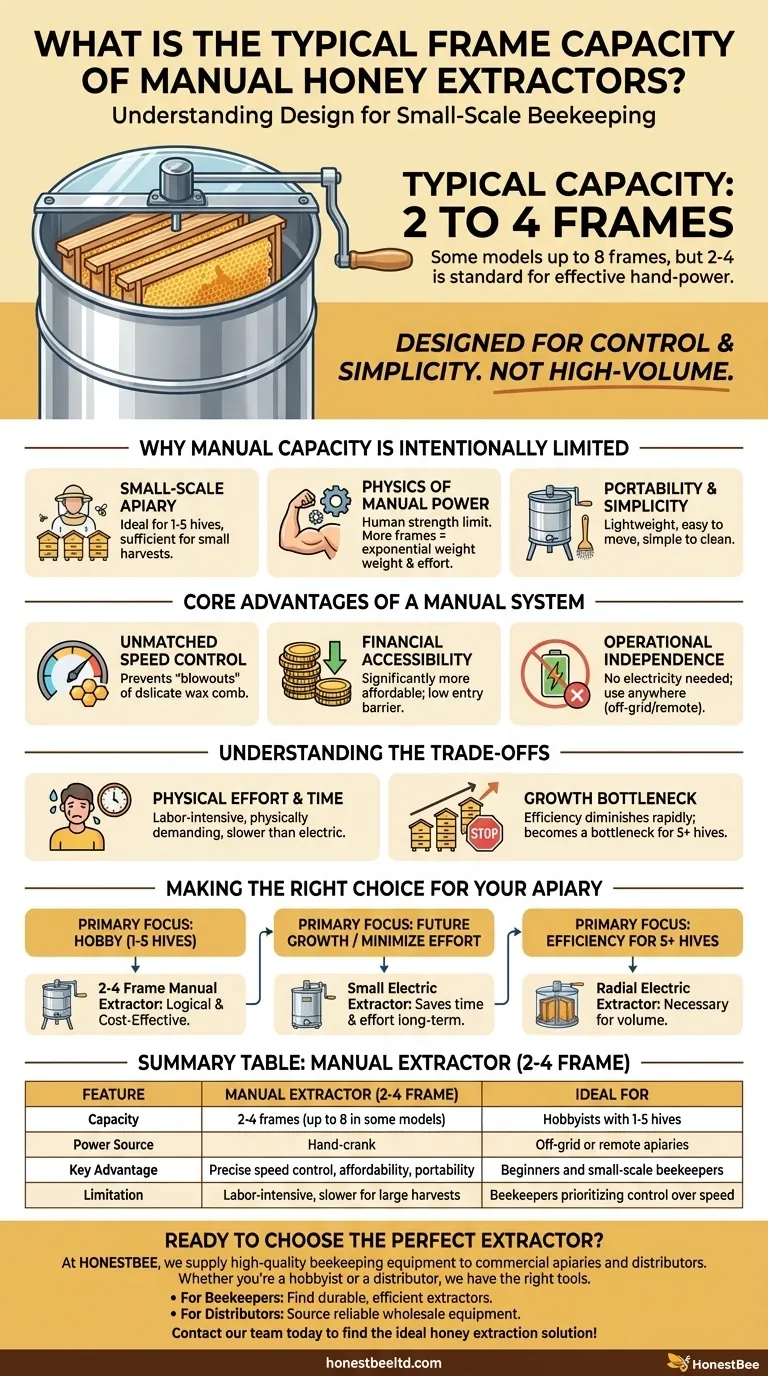To be direct, a typical manual honey extractor has a capacity of 2 to 4 frames. While some models can hold up to 8 frames, the vast majority are designed for smaller, more manageable loads that can be effectively powered by hand.
The limited capacity of a manual extractor isn't a design flaw; it's a deliberate feature. It aligns the tool with its intended user: the small-scale beekeeper who values control, simplicity, and affordability over high-volume production.

Why Manual Capacity is Intentionally Limited
Understanding the design constraints of a manual extractor reveals why it's a purpose-built tool for a specific type of beekeeper. The capacity is a direct reflection of its operational principles.
Designed for the Small-Scale Apiary
Manual extractors are built for hobbyists, typically those managing one to five hives. A 2-to-4-frame capacity is perfectly sufficient for harvesting from a small number of colonies without being excessive.
The Physics of Manual Power
The primary limitation is human strength. Spinning a drum full of honey-laden frames requires significant torque. As you add more frames, the weight and inertia increase exponentially, making it physically prohibitive to start and maintain the necessary speed by hand.
Prioritizing Portability and Simplicity
A smaller capacity keeps the extractor lightweight, easy to move, and simple to clean. This is a crucial advantage for hobbyists who may have limited storage space or need to extract honey in a kitchen or garage.
The Core Advantages of a Manual System
The lower capacity is directly tied to the key benefits that make manual extractors the ideal starting point for many beekeepers.
Unmatched Control Over Speed
Hand-cranking gives you precise, real-time control over the extraction speed. This is critical for preventing "blowouts," where the force of extraction destroys new or delicate wax comb.
Financial Accessibility
Manual extractors are significantly more affordable than their electric counterparts. This low barrier to entry makes them the most cost-effective and logical choice for beginners.
Operational Independence
Because they require no electricity, manual extractors can be used anywhere. This is a major benefit for beekeepers in remote locations or off-grid apiaries. They are also quieter and require less maintenance.
Understanding the Trade-offs
While ideal for many, the manual extractor's design comes with clear limitations that are important to acknowledge.
The Cost of Physical Effort
Extraction is a labor-intensive process. Cranking the handle, especially for multiple batches, requires considerable time and physical stamina. It is a workout.
Time as a Limiting Factor
Manual extraction is inherently slower than electric. For beekeepers with more than a few hives, the time required can become a significant bottleneck during the busy harvest season.
When You'll Outgrow It
As an apiary grows, the efficiency of a manual extractor diminishes rapidly. Once a beekeeper is managing more than five hives, the sheer volume of frames often makes upgrading to an electric model a practical necessity.
Making the Right Choice for Your Apiary
Your decision should be based on a clear assessment of your operational scale, budget, and long-term goals.
- If your primary focus is managing 1-5 hives as a hobby: A 2-to-4-frame manual extractor is the most logical and cost-effective tool for your needs.
- If your primary focus is future growth or minimizing physical labor: Investing in a small electric extractor from the start will save you time and effort as your apiary expands.
- If your primary focus is efficiency for 5+ hives: A manual extractor will be a bottleneck; a radial electric extractor is the necessary tool for handling this volume.
Ultimately, choosing the right extractor is about correctly matching the tool's design to the scale of your ambition.
Summary Table:
| Feature | Manual Extractor (2-4 Frame) | Ideal For |
|---|---|---|
| Capacity | 2-4 frames (up to 8 in some models) | Hobbyists with 1-5 hives |
| Power Source | Hand-crank | Off-grid or remote apiaries |
| Key Advantage | Precise speed control, affordability, portability | Beginners and small-scale beekeepers |
| Limitation | Labor-intensive, slower for large harvests | Beekeepers prioritizing control over speed |
Ready to Choose the Perfect Extractor for Your Apiary?
At HONESTBEE, we supply high-quality beekeeping equipment to commercial apiaries and distributors. Whether you're a hobbyist scaling up or a distributor stocking for the season, we have the right tools for your needs.
- For Beekeepers: Find durable, efficient extractors that match your hive count.
- For Distributors: Source reliable wholesale equipment your customers trust.
Let's discuss your specific requirements. Contact our team today to find the ideal honey extraction solution!
Visual Guide

Related Products
- 6 Frame Manual Stainless Steel Honey Extractor Beekeeping Equipment
- HONESTBEE 3-Frame Manual Acrylic Honey Extractor
- 2 Frame Stainless Steel Manual Honey Spinner Extractor for Beekeeping
- Plastic Hand Crank 2 Frame Honey Extractor Low Price
- Automatic Honey Frame Uncapper Machine for Beekeeping
People Also Ask
- What are the key stages of honey extraction? A Complete Guide for Beekeepers
- What are some tips for using a honey extractor effectively? Maximize Your Honey Yield and Protect Your Comb
- How long does it take to extract honey with an extractor? Plan Your Harvest for Maximum Efficiency
- What type of honey extractor is best? Maximize Your Harvest Efficiency with the Right Choice
- What tips can maximize honey extraction efficiency? Unlock Higher Yields and Purer Honey



















